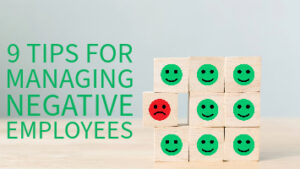A Guide to Turning Attitudes Around
Every workplace has its share of negative employees. You know who we’re talking about. The employee who brings a cloud of pessimism and complaints wherever they go. Their negativity grates on other employees’ nerves and lowers morale. While managing negative employees can be a challenging task, it is essential for maintaining a healthy and productive work environment.
First, you must identify when or if your team has a negative employee. Some leaders read this article because they know who that negative employee is. However, a leader may need to be made aware of the negativity and the impact of it on the rest of the team. If you are a leader experiencing low team morale or decreased productivity in more than one individual, do some digging and you might find one or more negative employees impacting your organization!
Spotting a Negative Employee
Negative behavior is subjective. However, the following scenarios and characterizations are consistent with negative employees. A negative employee:
- Finds flaws in every suggested solution
- Points out negative characteristics in other employees
- Doesn’t get along with others
- Talks poorly about leadership
- Gossips
- Frequently arrives late
- Misses deadlines
- Believes themselves to be indispensable
- Is most likely a highly productive employee
That last point makes it difficult for some leaders to manage negative employees. Though toxic employees cause problems within their team, they’re typically strong contributors. They understand their job and are good at it. However, the last thing you should do is look the other way simply because you value their contributions to the team.
The Impact of Negative Employees in the Workplace
The downsides of their negativity outweigh the positives by far. According to Harvard Business Review, leaders in Fortune 1,000 firms spend 13% of their work hours dealing with the consequences of workplace negativity. Additionally, they found that 48% of employees experiencing work negativity intentionally reduce their work effort. A study by the University of South Carolina deduces negativity in the workplace costs businesses $3 billion each year. Numerous studies have similar claims, as outlined in the other statistics shared in this article on social.com.
The bottom line is failing to deal with a toxic employee can lead to immeasurable consequences. So, how can you effectively turn those attitudes around?
Following are nine tips for turning your negative employee into a positive contributor:
-
Understand the Root Cause
Understanding the underlying root cause is crucial before addressing negative behavior. Negative attitudes can stem from personal issues, work-related frustrations, or lack of motivation. Take the time to sit down with the employee and have an open, non-confrontational conversation to uncover the root cause of their negativity. Be curious, not judgmental. This initial step can help build trust and pave the way for constructive solutions.
-
Provide Constructive Feedback
Negative employees may need to be made aware of their behavior’s impact on the team and the organization. Offer specific examples of their negative behavior and its consequences. Ensure your feedback is constructive and not accusatory. Use “I” statements to express your observations and feelings, and encourage them to share their perspective. A two-way dialogue can promote understanding and self-awareness.
-
Set Clear Expectations
Make sure your expectations for behavior and performance are clear. A lack of clarity can contribute to negativity, as employees may need to learn what you expect of them. Provide written guidelines, job descriptions, and performance metrics so employees know how to succeed.
-
Offer Support and Resources
Sometimes, negative attitudes are born out of frustration or being overwhelmed. Ensure your employees have the resources, training, and support to perform their jobs effectively. If they lack the skills to meet your expectations, offer training and mentorship to help them improve.
-
Encourage Problem-Solving
Negative employees often focus on problems rather than solutions. Encourage a problem-solving mindset by asking employees to produce possible solutions to the issues they complain about. This approach empowers them and shifts the focus from complaining to action.
-
Promote a Positive Work Environment
A hostile work environment can breed negativity. Foster a positive atmosphere by recognizing and celebrating achievements, encouraging teamwork, and promoting open communication. Lead by example and demonstrate the behavior you expect from your employees.
-
Implement a Performance Improvement Plan
If an employee’s negativity persists despite your efforts, consider implementing an effective performance improvement plan (PIP). A PIP outlines clear expectations, a timeline for improvement, and consequences if the negative behavior continues. It should be a collaborative process that involves the employee’s input.
-
Monitor Progress
Keep a close eye on the employee’s progress in improving their attitude and performance. You should provide regular feedback and support and adjust the plan as needed. Recognizing and rewarding positive changes will reinforce the desired behavior.
-
Know When to Let Go
In some cases, despite your best efforts, an employee’s negativity may continue to disrupt the workplace. If this happens, consider termination as a last resort. Make sure you follow all company policies and legal requirements in this process.
Managing negative employees can be challenging, but it is essential for maintaining a healthy and productive work environment. By understanding the root causes of negativity, providing feedback and support, promoting a positive work environment, and using performance improvement plans, you can help turn negative attitudes into positive contributions. Remember that every employee has the potential to change, and with the right approach, you can help them become valuable team members.

